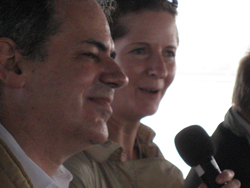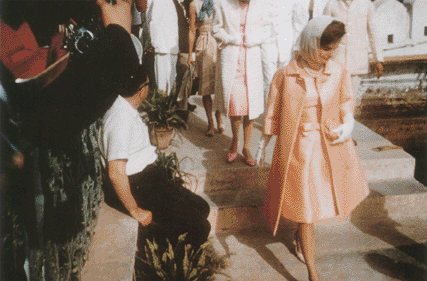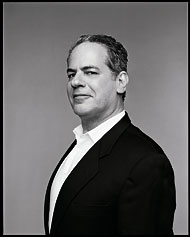Human Flower Project
Friday, October 05, 2007
Herbert Muschamp’s Palaces
Still wandering with exhilaration through the prose of a controversial critic.
 Herbert Muschamp and Linda Roy discussed architecture aboard the ‘Henry Hudson’ ferry
Herbert Muschamp and Linda Roy discussed architecture aboard the ‘Henry Hudson’ ferry
Photo: Dandubno
Architecture has always seemed such a dry, brittle discipline to us. We envision all those people in crisp white shirts edging forward in their tubular chairs, heads cocked slightly back to peer through little rectangular eyeglasses. They are talking about “space” so fast, at such length, so tediously, you feel for your pulse, stand and run from the room. And fashion? With the death camp eye shadow and trickles of white applause, it, too, seems a mean sport.
It took writer Herbert Muschamp to disabuse us of these prejudices. His “reviews” of architecture in the New York Times were architectural themselves. They were essays, really, with windows, balustrades, dark libraries, and terraces surrounded by fragrant trees. His writings were little palaces of thought, and unlike real-life palaces, they were inviting, amusing. His way of writing about couture and buildings suggested (gently) that our discomfort had been laziness, miserliness—an inferiority complex in the face of beauty, strength, and wealth.
Apparently, Muschamp was cast out of favor at the paper sometime around 2004. We saw his essays less and less. Some said he was fraternizing too often and too fondly with the designers he discussed in the paper. Other critic-critics seem to have found his prose maddening for the very reasons we loved it – the spirals of reasoning and the sudden personalizations – like coming unexpectedly upon a mirror at the end of a long hallway at night.

Jacqueline Kennedy visiting Lake Pichola in Udaipur, India
(wearing apricot Oleg Cassini silk ziberline coat and dress)
Photo: via City Review
One especially memorable piece was his review of the Metropolitan Museum’s “Jacqueline Kennedy: The White House Years,” an exhibition combining news photography and costume. We remember at first being startled that the architecture critic would write about fabric and hats—Jackie. “Photographed from the back as a campaign limousine heads up Fifth Avenue, she waves her gloved hand, unfurling the broad sleeve of her coat like the wing of some gorgeous descendant of a prehistoric bird of prey.”
And so we continued…
“There was a Darwinian aspect to the 1960 election: the survival of the most attractive. Since Mrs. Kennedy outranked her husband on that evolutionary scale, her contribution to the Democratic victory should not be minimized. We were now well into the cold war. And we had learned that this war would be fought not with weapons but with images. The missile gap was more a matter of perceptions than facts. Nuclear deterrence was propaganda. If a Soviet leader was crass enough to bang his shoe on the table at the United Nations, what other savagery might he be capable of?…”
Muschamp’s latest palace had come into view.
With such freshness he was able to evoke particular moments in history and distill them into extracts – blended for cultural revelation and dashing, like fine perfume.
Herbert Muschamp died this week, age 59, of lung cancer. We hope that you will have access to the announcement in the New York Times, though we found the obituary drab, almost comically so (What a good time he might have had with that assignment!). But the Times links to many, many of his wonderful essays. The Secret History of 2 Columbus Circle is another of our favorites. We’ve never read most of these—a lot to look forward to.

Jacqueline Kennedy and President Mohammad Ayub Khan
Lahore, Pakistan, March 21, 1962
(wearing blue silk-and-wool Alaskine coat by Oleg Cassini)
Photo: John F. Kennedy Library via the Metropolitan Museum of Art
The aim to disclose culture through the experience of flowers may grow out of intellectual cowardice, humility or hubris. It may be just a personal form of restlessness. Does it matter? Maybe, if that aim creates anything worthwhile.
We’re exhilarated by how Muschamp extended criticism in our own time, of our own time. These are welcoming palaces, and we’ll revisit them. His essay on the Jackie Kennedy White House Years ends this way, reflecting on the final image of the Met show:
“A black-and-white photograph, greatly enlarged, depicts the president and Mrs. Kennedy sitting in the back of a limousine. The two are smiling at each other. It freezes a classic public-private moment: a scene of intimacy between two people at the center of a nation that had yet to discover that everyone wants to be a star.
“The scene is not Dallas, the year not 1963, though I think we’re meant to be jolted by the possibility that these two stunning creatures are headed for an appointment in Samara. We’re relieved to discover that the picture was taken the year before, but the discovery precipitates an even worse letdown because the picture was made in an America that had yet to be blown apart, first by one assassin, then by an army of them, until we had exhausted faith in our destiny and the entire world’s supply of good will that the Kennedys had helped to inspire.
 Herbert Muschamp
Herbert Muschamp
Photo: Robert Maxwell, for The New York Times
“Wallowing in our poison now seems to be the national pastime. Art may not be the highest form of redemption from toxicity, but it’s a good one. In the show’s last gallery we see fashion transformed into something more enduring: the preservation of architectural landmarks, a field that continued to hold Mrs. Kennedy’s interest beyond the White House years. But throughout the show we see glimpses of her contributions to the arts: gala performances at the White House, speeches she gave on visits overseas.
“It was possible, back in the early 1960’s, to discount this work as the purely ornamental pastime of a young first lady. It seemed of a piece with seating a dinner, arranging flowers, redecorating the premises. It is not possible to make that mistake today, when culture has assumed such a major role politically and economically in the conduct of world affairs. It does not seem a small thing now to have made art a matter of national policy. In an age still racked by fear—missile shield, anyone?—it is vivifying to be reminded that the desire for beauty can survive the rage to destroy.”




